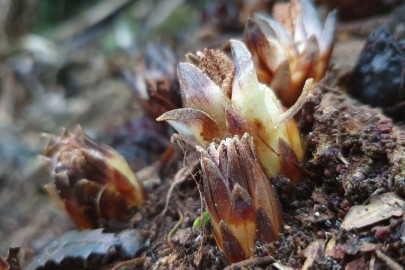Core blimey: how an old Hoover revealed the secrets of a wetland

Dactylanthus taylorii, or the wood rose. Image: Marti, CC BY-NC, via iNaturalist.
Janet suggested Malcolm collect a few samples of peat from the wetland to get the research started. He and Tim hammered an old vacuum cleaner tube into the ground on the edge of a newly fenced and covenanted wetland.
Janet received a nicely ‘vacuumsealed’ core she could analyse under the microscope. “Pollen analysis provided us with a list of at least 43 pollen and fern spore types,” she says. “This included podocarp trees such as rimu, miro and tōtara, as well as numerous broadleaf trees and shrubs that made up the canopy, including maire, pōkākā, māhoe, akeake, rewarewa, kohekohe, and nīkau.”
She also recorded the presence of tree ferns, climbers, perching plants, parasitic plants, and ground ferns. “It’s a huge increase from the 11 known native species from the wetland today.”
Janet says one of the most exciting finds was pollen of te pua o te rēinga (Dactylanthus taylorii), or the wood rose, a semi-parasitic and now nationally threatened plant that grows as a root-like stem attached to the root of a host tree. “Its distinctive pollen is rarely found in the pollen record, but I have recorded it before in pre-human sediments from Lake Tūtira.”
Janet’s analysis suggested the site was formerly a shallow lake surrounded by tall forest rather than a wetland. Because there were no signs of charcoal in the samples, the sediments probably started accumulating in the pre-human era between 3,000 and 1,000 years ago.
Janet compared the pollen spores from Tim’s Frasertown farm with records from other regions in Gisborne and the Hawke’s Bay. “Pollen records show us what the vegetation was like across New Zealand long before people arrived,” she says. “Understanding what plant species survived and flourished in an area in the past is a good reference point for informing current land-management decisions.”

